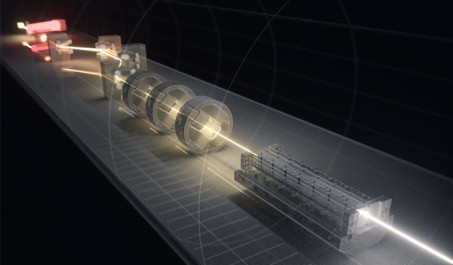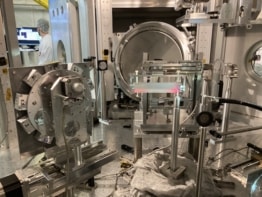
X-ray free-electron lasers (XFELs) are used to create extreme matter conditions, enabling fundamental research in areas such as materials science, hot-dense-matter research and drug development. Currently, such lasers are behemoths, requiring kilometre-scale set-ups costing billions. Researchers at Strathclyde University in the UK have now put forward a new blueprint for a miniaturized XFEL based on a plasma wakefield accelerator (PWFA). The device, which would be just a few metres in size, could herald the advent of next-generation ultracompact XFELs, they say.
“FELs contain a relativistic electron beam swinging on a sinusoidal path inside an ‘undulator’ with an alternating magnetic field,” explains lead researcher Fahim Habib. “As a result of the wiggling motion, the electron beam emits bursts of photons and a positive feedback effect structures the electron beam into micro-bunches at the radiation wavelength.”
The result of this bunching is that the radiation power grows exponentially along the undulator and becomes highly coherent. However, this self-organizing effect can only occur if the electron beam is of a high quality at relativistic energies. Such high beam quality is achieved today using linear accelerators (linacs), which make the XFELs kilometres long.
Plasma-based accelerators
Plasma-based accelerators could produce such multi-gigaelectronvolt (GeV) beams on much shorter distances, of just centimetres, with beam qualities approaching those required for XFELs. Habib and colleagues have now shown that electron beams from plasma photocathodes may be much brighter than those produced in linacs and can be produced in a PWFA.
Wakefield accelerators operate by firing a dense beam of charged particles like electrons into a stationary plasma (essentially a gas of ionized particles). The electron beam separates negative charges (electrons) from the stationary background ions in the target creating a short trailing plasma wave. The electric field associated with this plasma wave accelerates charged particles that trail in its wake, which is where the term wakefield comes from. If a trailing bunch of charged particles is timed properly, it can surf this wave and be accelerated steeply – to kinetic energies of GeV over distances of just few centimetres. Yet, the beam quality is far from that required for XFELs
The advanced PWFA developed by Habib and colleagues is equipped with a novel electron injection method called a plasma photocathode (aka the “Trojan horse”) and can produce electron beams 100,000 times brighter than those in linacs thanks to the beams’ low momentum spread distribution.
Entire system is just a few metres in size
In their work, which is detailed in Nature Communications, the researchers studied how to extract, transport, isolate and inject the ultrahigh-brightness electron beams from the plasma photocathode PWFA into an undulator without charge and quality loss. “Focused into an undulator, the ultrahigh-quality electron beam produces powerful coherent photon pulses at Angstrom wavelengths on the fly with a pulse duration at the attosecond level,” explains Habib. “The fascinating part is that the entire system is just a few metres in size compared with state-of-the-art kilometre-size XFEL machines.”

UK kicks off design work for an X-ray free-electron laser
“While there is much work ahead, our results are the first milestones towards the next-generation ultracompact XFELs. Our vision is to advance this technology to a standard tool for university-level labs or even hospitals,” Habib tells Physics World.
“The first experimental evidence for plasma photocathode injection in PWFA was obtained in our Trojan horse collaboration at our strategic partner Stanford’s SLAC FACET facility,” adds team leader Bernhard Hidding. “Now, with our programme at the successor facility, SLAC FACET-II, we aim to exploit the true potential of the scheme in terms of beam quality and stability.”


